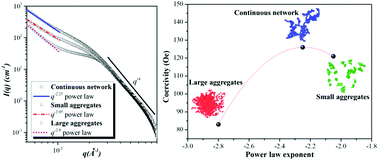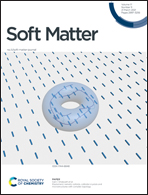Hierarchical structure in poly(N-vinyl carbazole)/Fe3O4 nanocomposites and the relevant magnetic coercivity†
Abstract
In this study, we report the dependence of the nanoparticle dispersion on the zero-conversion initiator efficiency in the nanocomposites formed by poly(N-vinyl carbazole) (PNVK) and acrylic acid-modified iron oxide (AA-Fe3O4) nanoparticles via free radical solution polymerization of the precursor solution, that is, a thorough mixture of 28.5 wt% AA-Fe3O4 nanoparticles and the N-vinyl carbazole (NVK) monomer with the solvent dimethylformamide and azobisisobutyronitrile as an initiator. Here three different types of the dispersion state of AA-Fe3O4 nanoparticles in the PNVK matrix have been distinguished by a combined approach of transmission electron microscopy and small-angle X-ray scattering coupled with real-space models of the nanoparticle assemblies. When the polymerization proceeded with a higher zero-conversion initiator efficiency (f°) by pre-polymerization at 115 °C, the generation of a large amount of free radicals could efficiently induce the dominant surface-initiated polymerization of the NVK monomer with the vinyl groups of tethered acrylic acids; in this case, the constitution of “shorter multiple grafted PNVK chains” threaded AA-Fe3O4 nanoparticles to form particle branches and the branches were joined together from branching points along each branch, thereby forming the network structure. However, once the polymerization was conducted at a lower f° by pre-polymerization at 75 °C, a significant reduction in the generation of free radicals likely greatly reduced the efficiency in the occurrence of surface-initiated polymerization at particle surfaces; nevertheless, the self-polymerization of the NVK monomer could still take place to induce a local demixing between the polymerizing longer PNVK chains and AA-Fe3O4 nanoparticles via the attractive depletion mechanism, thus locally leading to the formation of small aggregates. While if the f° was controlled to be intermediate by polymerization at 100 °C, an optimal balance between the rates of the surface-initiated polymerization and the self-polymerization induced a collective construction built from the network and aggregate structures, exhibiting the structural characteristics of large aggregates. Furthermore, the magnetic coercivity of PNVK/AA-Fe3O4 nanocomposites was found to depend on the dispersion state of the AA-Fe3O4 nanoparticles, presenting a tendency towards enhanced coercivity as the dispersion state changed from large aggregates to small aggregates to network structure.



 Please wait while we load your content...
Please wait while we load your content...